The strangest things find themselves at the center of the culture wars. In the late 1980s, evangelicals—bolstered by the vicious conservatism of the Reagan and Bush years—zeroed in on the National Endowment for the Arts for its willingness to fund exhibitions by transgressive artists like Robert Mapplethorpe and Andres Serrano. The words of then-Senator Jesse Helms, who championed the fight against the NEA, are recited by a pair of zealous, campily hick-ish voices over the end credits of Barbara Hammer’s Nitrate Kisses (1992): “These artists, who have their minds in the gutter, are free to do whatever they want to do, on their own time and with their own money.” The screed is a winking, reclamatory acknowledgement of that assault on queer expression, only the latest in the sprawling history of censorship, omission, and repression that Hammer’s experimental documentary narrates.
The film, Hammer’s first feature after two prolific decades of short work, features a chorus of undifferentiated and unidentified voices. They offer snippets of personal history—playing doctor, crushes on teachers, cruising experiences—alongside reflections on Willa Cather, 1920s blues music, and the unique plight of “asocial” prisoners in Nazi concentration camps. The words of these narrators, gays and lesbians whose voices reflect a range of ages and nationalities, assemble queer history not as a timeline but as a web of collective and individual memory, often difficult to pin down in the historical record.
An intertitle, one of many that flash on screen in block letters like Jenny Holzer truisms, declares: “Effective history does not retrieve events/actors lost by official history but shows the processes that produced those losses, those constructed silences.” Nitrate Kisses is as concerned with queer history as with the forces that have erased and curbed it. One speaker describes the censorship engendered by the Motion Picture Production Code, which forced so-called “sexual perversion” into the subtextual and implicit. In a bold repudiation of its prohibitions, Hammer runs the text of the Code over a close-up shot of two men having sex.
The pair is among a few couples whose physical intimacy is spliced in amongst archival photos and abstract B-roll. As in much of her early work, Hammer puts sex in playful conversation with text: “We have only our oral histories,” one narrator bemoans over a shot of a punky leatherdyke giving another head. Replete with latex gloves and dental dams, these scenes bear the shadow of the AIDS epidemic, another force of history that threatened to obliterate queer life and art. Like the arcs of violence that preceded it, it did not succeed.
Nitrate Kisses screens this afternoon, June 3, and on June 11, at the Museum of the Moving Image as part of the series “Queer Cinema, Top to Bottom.”



